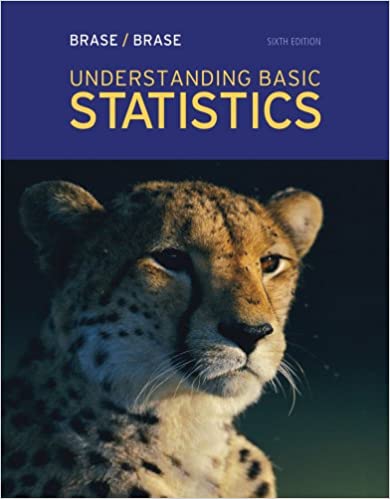
Understanding Basic Statistics 6th Edition by Charles Henry Brase,Corrinne Pellillo Brase
Edition 6ISBN: 978-1111827021
Understanding Basic Statistics 6th Edition by Charles Henry Brase,Corrinne Pellillo Brase
Edition 6ISBN: 978-1111827021 Exercise 50
Critical Thinking: Exchange x and y in Least-Squares Equation
(a) Suppose you are given the following ( x , y ) data pairs:

Show that the least-squares equation for these data is = 0.143 + 1.071 x (rounded to three digits after the decimal).
(b) Now suppose you are given these ( x , y ) data pairs:

Show that the least-squares equation for these data is = 1.595 + 0.357 x (rounded to three digits after the decimal).
(c) In the data for parts (a) and (b), did we simply exchange the x and y values of each data pair
(d) Solve = 0.143 + 1.071 x for x. Do you get the least-squares equation of part (b) with the symbols x and y exchanged
(e) In general, suppose we have the least-squares equation = a + bx for a set of data pairs ( x , y ). If we solve this equation for x , will we necessarily get the least-squares equation for the set of data pairs ( y , x ) (with x and y exchanged) Explain using parts (a) through (d).
(a) Suppose you are given the following ( x , y ) data pairs:

Show that the least-squares equation for these data is = 0.143 + 1.071 x (rounded to three digits after the decimal).
(b) Now suppose you are given these ( x , y ) data pairs:

Show that the least-squares equation for these data is = 1.595 + 0.357 x (rounded to three digits after the decimal).
(c) In the data for parts (a) and (b), did we simply exchange the x and y values of each data pair
(d) Solve = 0.143 + 1.071 x for x. Do you get the least-squares equation of part (b) with the symbols x and y exchanged
(e) In general, suppose we have the least-squares equation = a + bx for a set of data pairs ( x , y ). If we solve this equation for x , will we necessarily get the least-squares equation for the set of data pairs ( y , x ) (with x and y exchanged) Explain using parts (a) through (d).
Explanation
(a) Computation Table:
The above tabl...
Understanding Basic Statistics 6th Edition by Charles Henry Brase,Corrinne Pellillo Brase
Why don’t you like this exercise?
Other Minimum 8 character and maximum 255 character
Character 255


